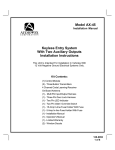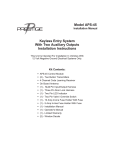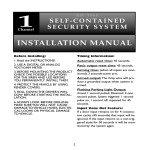Download Directed Electronics G Hurricane 3 6 Automobile Alarm User Manual
Transcript
Owner's Guide Limited Lifetime Consumer Warranty For a period of one calendar year from the date of purchase of this auto-security device, Directed Electronics, Inc. promises to the ORIGINAL PURCHASER to repair or replace (with a comparable reconditioned model), free of cost, any electronic control module which proves to be defective in workmanship or material under normal use, SO LONG AS THE SYSTEM WAS SOLD, INSTALLED, AND SERVICED BY A PROFESSIONAL AUTO INSTALLER, AND REMAINS IN THE CAR IN WHICH THE SYSTEM WAS ORIGINALLY INSTALLED. If warranty service is necessary you must have a clear copy of your sales receipt containing all of the information shown on the following page. After the first calendar year, from the date of purchase of this auto-security device, Directed Electronics, Inc., promises to the ORIGINAL PURCHASER to repair or replace (with a comparable reconditioned model) any electronic control module which proves to be defective in workmanship or material under normal use FOR A CHARGE OF $45.00, SO LONG AS THE SYSTEM WAS SOLD, INSTALLED, AND SERVICED BY A PROFESSIONAL AUTO INSTALLER, AND REMAINS IN THE CAR IN WHICH THE SYSTEM WAS ORIGINALLY INSTALLED. If warranty service is necessary you must have a clear copy of your sales receipt containing all of the information shown on the following page. This warranty contains the entire agreement relating to warranty and supersedes all previous and contemporaneous representations or understandings, whether written or oral. IN ANY EVENT, DEI IS NOT LIABLE FOR THE THEFT OF THE VEHICLE AND/OR ITS CONTENTS. This warranty is void if the product has been damaged by accident, unreasonable use, neglect, improper service or other causes not arising out of defects in materials or construction. This warranty is nontransferable and does not apply to any unit that has been modified or used in a manner contrary to its intended purpose and does not cover batteries. The unit in question must be returned to the manufacturer, postage prepaid. This warranty does not cover labor costs for the removal, diagnosis, troubleshooting or reinstallation of the unit. For service on an out-of-warranty product a flat rate fee by model is charged. Contact your authorized dealer to obtain the service charge for your unit. © 2000 Directed Electronics, Inc. i These systems are a deterrent against possible theft. Directed Electronics, Inc. is not offering a guarantee or insuring against the theft of the automobile or its contents and disclaims any liability for the theft of the vehicle and/or its contents. Directed Electronics does not authorize any person to create for it any other obligation or liability in connection with this security system. TO THE MAXIMUM EXTENT ALLOWED BY LAW, ANY AND ALL WARRANTIES ARE EXCLUDED BY THE MANUFACTURER AND EACH ENTITY PARTICIPATING IN THE STREAM OF COMMERCE THEREWITH. THIS EXCLUSION INCLUDES BUT IS NOT LIMITED TO THE EXCLUSION OF ANY AND ALL WARRANTY OF MERCHANTABILITY AND/OR ANY AND ALL WARRANTY OF FITNESS FOR A PARTICULAR PURPOSE AND/OR ANY AND ALL WARRANTY OF NON-INFRINGEMENT OF PATENTS, IN THE UNITED STATES OF AMERICA AND/OR ABROAD. NEITHER THE MANUFACTURER OR ANY ENTITIES CONNECTED THEREWITH SHALL BE RESPONSIBLE OR LIABLE FOR ANY DAMAGES WHATSOEVER, INCLUDING BUT NOT LIMITED TO ANY CONSEQUENTIAL DAMAGES, INCIDENTAL DAMAGES, TOWING, REPAIR, REPLACEMENT, DAMAGES FOR LOSS OF TIME, LOSS OF EARNINGS, COMMERCIAL LOSS, LOSS OF ECONOMIC OPPORTUNITY AND THE LIKE. NOTWITHSTANDING THE ABOVE, MANUFACTURER DOES OFFER A LIMITED WARRANTY TO REPLACE OR REPAIR THE CONTROL MODULE AS DESCRIBED ABOVE. Some states do not allow limitations on how long an implied warranty will last or the exclusion or limitation of incidental or consequential damages. This warranty gives you specific legal rights, and you may also have other rights which vary from state to state. IMPORTANT NOTE: This product warranty is automatically void if its date code or serial number is defaced, missing, or altered. This warranty will not be valid unless you have completed the warranty card and mailed it to Directed Electronics, Inc. within 10 days after purchase to the address listed on the warranty registration card. Make sure you have all of the following information from your dealer: A clear copy of the sales receipt, showing the following: ■ ■ ■ ■ ■ ■ ■ ■ ■ ii Date of purchase Your full name and address Authorized dealer's company name and address Type of system installed Year, make, model and color of the automobile Automobile license number Vehicle identification number All security options installed on automobile Installation receipts © 2000 Directed Electronics, Inc. Table of Contents Limited Lifetime Consumer Warranty . . . . . . . . . . . . . . . . . . . . . . . . . . . . i What Is Included . . . . . . . . . . . . . . . . . . . . . . . . . . . . . . . . . . . . . . . . . 3 Important Information . . . . . . . . . . . . . . . . . . . . . . . . . . . . . . . . . . . . . 3 System Maintenance . . . . . . . . . . . . . . . . . . . . . . . . . . . . . . . . . . . . . . 3 FCC/ID Notice. . . . . . . . . . . . . . . . . . . . . . . . . . . . . . . . . . . . . . . . . . 4 Transmitter Functions . . . . . . . . . . . . . . . . . . . . . . . . . . . . . . . . . . . . . . 4 Standard Configuration . . . . . . . . . . . . . . . . . . . . . . . . . . . . . . . . . . . . 4 Using Your System . . . . . . . . . . . . . . . . . . . . . . . . . . . . . . . . . . . . . . . . 6 Arming . . . . . . . . . . . . . . . . . . . . . . . . . . . . . . . . . . . . . . . . . . . . . . 6 Arming While Driving . . . . . . . . . . . . . . . . . . . . . . . . . . . . . . . . . . . . . 8 Disarming . . . . . . . . . . . . . . . . . . . . . . . . . . . . . . . . . . . . . . . . . . . . 8 High Security Disarm . . . . . . . . . . . . . . . . . . . . . . . . . . . . . . . . . . . . . 8 Disarming Without a Transmitter . . . . . . . . . . . . . . . . . . . . . . . . . . . . . . 9 Silent Mode . . . . . . . . . . . . . . . . . . . . . . . . . . . . . . . . . . . . . . . . . . . 10 Panic Mode . . . . . . . . . . . . . . . . . . . . . . . . . . . . . . . . . . . . . . . . . . . 10 Valet Mode . . . . . . . . . . . . . . . . . . . . . . . . . . . . . . . . . . . . . . . . . . . 10 Remote Valet . . . . . . . . . . . . . . . . . . . . . . . . . . . . . . . . . . . . . . . . . . 11 False Alarm Prevention Circuitry . . . . . . . . . . . . . . . . . . . . . . . . . . . . . . . 11 Diagnostics . . . . . . . . . . . . . . . . . . . . . . . . . . . . . . . . . . . . . . . . . . . . . 12 Arming Diagnostics . . . . . . . . . . . . . . . . . . . . . . . . . . . . . . . . . . . . . . 13 Disarming Diagnostics . . . . . . . . . . . . . . . . . . . . . . . . . . . . . . . . . . . . . 13 Table of Zones . . . . . . . . . . . . . . . . . . . . . . . . . . . . . . . . . . . . . . . . . 14 Owner Recognition . . . . . . . . . . . . . . . . . . . . . . . . . . . . . . . . . . . . . . . . 14 Code Hopping . . . . . . . . . . . . . . . . . . . . . . . . . . . . . . . . . . . . . . . . . . . 15 Rapid Resume Logic . . . . . . . . . . . . . . . . . . . . . . . . . . . . . . . . . . . . . . . 15 Multi-Vehicle Operation. . . . . . . . . . . . . . . . . . . . . . . . . . . . . . . . . . . . . 16 Programming Options . . . . . . . . . . . . . . . . . . . . . . . . . . . . . . . . . . . . . . 16 Installation Options . . . . . . . . . . . . . . . . . . . . . . . . . . . . . . . . . . . . . . . 17 Security and Luxury Expansions . . . . . . . . . . . . . . . . . . . . . . . . . . . . . . . 17 Glossary of Terms . . . . . . . . . . . . . . . . . . . . . . . . . . . . . . . . . . . . . . . . . 18 Quick Reference Guide (Removable) . . . . . . . . . . . . . . . . . . . . . . . . . . . . 21 © 2000 Directed Electronics, Inc. 1 Standard Configuration controls the Arm function. controls the Disarm function. controls Silent Mode™and an Auxiliary Output. controls the Panic function. and and 2 pressed simultaneously control Remote Start. pressed simultaneously control an Auxiliary Output. © 2000 Directed Electronics, Inc. What is Included ■ A control module ■ Two four-button remote transmitters ■ A dual-stage shock sensor (on-board the control module) ■ A soft chirp, six-tone siren ■ A red status LED indicator light ■ A push-button Valet switch ■ A starter interrupt relay Important Information Congratulations on the purchase of your state-of-the-art vehicle security system. This system has been designed to provide years of trouble-free operation. By carefully reading this owner's guide, you will maximize the use of this system and its features. System Maintenance The system requires no specific maintenance. Your remote is powered by a small, lightweight 3-volt lithium battery that will last approximately one year under normal use. When the battery begins to weaken, operating range will be reduced and the LED on the remote will dim. To access the battery for replacement, remove the rear cover of the remote with a small, flat-blade screwdriver. © 2000 Directed Electronics, Inc. 3 FCC/ID Notice This device complies with Part 15 of FCC rules. Operation is subject to the following two conditions: (1) This device may not cause harmful interference, and (2) This device must accept any interference received, including interference that may cause undesired operation. Caution: Changes or modifications not expressly approved by the party responsible for compliance could void the user's authority to operate this device. Transmitter Functions Your vehicle security system is programmable, making it possible to assign any button on the transmitter to any specific receiver function. The remote transmitter initially comes programmed with the Standard Configuration, but may also be customized by an authorized dealer. All instructions in this manual assume operation using the Standard Configuration. Standard Configuration The functions of the buttons described in this section correspond to a remote transmitter programmed with the default Standard Configuration. These buttons will function differently in a Custom Configuration. 4 © 2000 Directed Electronics, Inc. LOCK/ARM Button Pressing arms the security system and locks the vehicle doors. UNLOCK/DISARM Button Pressing disarms the security system and unlocks the vehicle doors. AUX Button Silent Mode and trunk release are controlled by pressing (Pressing . for less than one second before arming or disarm- ing activates Silent Mode. Pressing and holding for 1.5 seconds engages the trunk release.) PANIC Button Pressing and holding for 1.5 seconds activates the Panic Mode. LOCK/ARM and UNLOCK/DISARM Buttons An optional auxiliary convenience or expansion function that you have added to your system can be activated by pressing and simultaneously. This auxiliary output controls_____________________________. AUX and PANIC Buttons Another optional auxiliary convenience or expansion function that you have added to your system can be activated by pressing and simultaneously. This auxiliary output controls_____________________________. © 2000 Directed Electronics, Inc. 5 Using Your System Remember, use of the buttons described in all instructions in this manual corresponds to the Standard Configuration, unless otherwise specified. Arming You can arm the security system and lock your vehicle's doors by pressing for one second. When the system arms, you will hear a short siren sound (chirp) and the parking lights will flash once. Once armed, the status LED will flash once per second to indicate that the system is actively protecting your vehicle. If you hear a second chirp after arming and notice that the status LED is flashing in a grouped pattern, this signals Bypass Notification. Bypass Notification is described in further detail in the Diagnostics section of this manual. Your vehicle security system can also be programmed to arm itself automatically 30 seconds after the ignition is turned off and the last vehicle door has been closed (called Passive Arming). Once the 30-second countdown period initiates, the status LED will flash twice as fast as it does when the system is armed. After 20 seconds, the siren will chirp once to warn that the system has only 10 seconds remaining prior to arming. The system is not actually armed at this point. The system arms itself at the 30-second mark. At this point, the vehicle doors will also lock (if programmed for 6 © 2000 Directed Electronics, Inc. Passive Locking) and the status LED will begin flashing once per second to indicate armed status. If the system is programmed for Passive Locking, care must be taken to prevent the keys from being locked in the vehicle. NOTE: If any protected entry point (such as a door or switch-protected trunk or hood) is open, Passive Arming will not engage. Additionally, each time a sensor is triggered during the 30-second arming countdown, the countdown starts over. Arming your security system protects your vehicle in the following ways: ■ Light impacts trigger a Warn Away Response, causing the siren to chirp and the parking lights to flash for a few seconds. ■ Heavy impacts trip a triggered sequence, which consists of the siren sounding continuously and the parking lights flashing for 30 seconds. ■ If a door is opened, the siren immediately starts chirping and the parking lights start flashing to provide an instant response. Three seconds later, the siren output changes to a continuous blast. This two-stage progressive response allows you time to disarm the security system with your remote transmitter, in case the door is inadvertently opened while the system is armed. ■ Turning on the ignition key triggers the same two-stage progressive response as opening a door. ■ The starter interrupt relay prevents the vehicle’s starter from cranking. © 2000 Directed Electronics, Inc. 7 Arming While Driving This feature provides added security while travelling in an unfamiliar or potentially dangerous area. To arm your security system while driving, press on the transmitter for 1.5 seconds while the vehicle is running or the ignition is on. You will hear one chirp that confirms the system has been armed, followed by another chirp that indicates the ignition is on. While the vehicle is running, the security system will not respond to any input except the door triggers; the starter interrupt relay will also be disarmed. When the ignition is turned off, the security system will disarm automatically. This will be confirmed when the siren chirps twice and the LED stops flashing. Disarming Press to disarm the security system, unlock the doors, and turn on the dome light for 30 seconds. Disarming is confirmed when the parking lights flash twice and the siren emits two chirps. The status LED will also stop flashing. The siren chirping either four or five times when disarming indicates Tamper Alert, which is described in the Diagnostics section of this manual. High Security Disarm High Security Disarm allows you to silence and reset the security system when it is triggered, without having to disarm the system. This prevents you from having to visually check your vehicle when the system has been triggered. If the siren has been sounding for 8 © 2000 Directed Electronics, Inc. longer than six seconds, press to stop the trigger and reset the system to its armed state. Pressing an additional time will disarm the system. To disarm the system immediately, press during the first six seconds of the Triggered Sequence. Disarming Without a Transmitter If your remote transmitter is lost or damaged, you can manually disarm your vehicle security system. To disarm the system without a transmitter, you must have the vehicle's ignition key and know where the Valet switch is located. Be sure to check with your installer at the time of installation for both the location and the preset response (1-5 presses) of the Valet switch. To disarm the security system, turn the ignition key on and press the Valet switch the preset number of times (1-5 presses) within 15 seconds. If the system DRW-35 does not disarm, you may have waited too long to press the Valet switch; turn the ignition off and repeat the process. IMPORTANT! The Valet switch can be programmed to respond to 1-5 presses for the disarm function. You must check with the installer to verify the programming for your individual unit. LOCATION OF VALET SWITCH______________________________ © 2000 Directed Electronics, Inc. 9 Silent Mode Use the Silent Mode to temporarily turn off the arm or disarm confirmation chirps by briefly pressing before either arming or disarming. The confirmation chirp(s) will then be eliminated for that one operation only. To permanently turn off the arm and disarm confirmation chirps, contact your installation dealer. NOTE: The Warn Away Response to lighter impacts is bypassed if the security system is armed using the Silent Mode. This ensures that the siren does not chirp in an environment where you don't want chirps to be emitted. The security system is still capable of being triggered by heavier impacts; only the Warn Away Response generated by light impacts is bypassed. Panic Mode If you are threatened in or near your vehicle, press on your transmitter for 1.5 seconds to trigger your security system and attract attention. The siren will sound and the parking lights will flash for 30 seconds. To stop the Panic Mode at any time, press , , or . Valet Mode Valet Mode prevents your security system from arming and triggering either automatically or with the remote transmitter. In Valet Mode, all convenience functions (door locks, trunk release, etc.) remain operational. This feature is useful when washing or servicing your vehicle. 10 © 2000 Directed Electronics, Inc. To enter or exit Valet Mode: 1. Turn the ignition on. 2. Turn the ignition off. 3. Press and release the Valet switch within 10 seconds. DRW-35 The status LED will light steadily if you are entering Valet Mode and will turn off if you are exiting Valet Mode. Remote Valet You can also activate Valet Mode with the remote transmitter: 1. Open any vehicle door. 2. Press . 3. Press . 4. Press again. The status LED will light solid if you are entering Valet Mode and will turn off if you are exiting Valet Mode. False Alarm Prevention Circuitry Your system has circuitry to prevent annoying false alarms. This circuitry prevents repetitive trigger sequences due to faulty door pinswitches or environmental conditions such as thunder, jackhammers, airport noise, etc. Here's how it works: If the alarm is triggered by the same sensor or switch three times within a 60 minute period, your system interprets this pattern of triggers as false alarms. After the third trigger, © 2000 Directed Electronics, Inc. 11 your system ignores, or bypasses, that sensor or switch (along with any other sensors or switches sharing the same zone) for 60 minutes. If the bypassed sensor is triggered again while it is already being bypassed, the 60-minute bypass period will start over. This ensures that a sensor that is continually being triggered will remain bypassed. The vehicle doors are protected differently. If your security system is triggered by an open door for three, full 30-second cycles (one and one half minutes), the system will bypass the doors until the trigger ceases. NOTE: Arming and disarming the system does not reset the False Alarm Prevention. The only ways to reset a bypassed zone are for that zone not to be triggered for 60 minutes or to turn the ignition key on. When testing your system, it is important to remember that this circuitry can cause zones to be bypassed and appear to not work. If five chirps are heard when disarming the system, False Alarm Protection was engaged. To clear the memory, turn the ignition key on. Diagnostics The microprocessor at the heart of your system has the ability to constantly monitor all of the switches and sensors connected to it. It can detect any faulty switches or sensors and prevent them from disabling the entire system. It can also record and report any triggers that occur when you are away from your vehicle. 12 © 2000 Directed Electronics, Inc. Arming Diagnostics If the system is armed at the same time that an input is active (door opening, sensor triggering, etc.), you will hear one chirp to indicate arming and a second chirp to indicate Bypass Notification. A Bypass Notification chirp means that the system ignores the input that was active when the system was armed, until that input ceases. Three seconds after that input ceases, the system will resume normal monitoring. For example, if your vehicle has an interior light exit delay and you arm the system before the light turns off, you may hear a second Bypass Notification chirp. Once the light turns off, however, the system resumes normal monitoring. NOTE: Bypass Notification does not occur when the system is in Silent Mode or if the chirps are programmed by the installer not to sound. Disarming Diagnostics Your system has a Tamper Alert feature that notifies you of system triggers that occur while you are away from your vehicle. If you hear four chirps when you disarm, this indicates that the system was triggered in your absence. Five chirps when you disarm indicates that a specific zone was triggered so many times that the False Alarm Prevention Circuitry has bypassed that zone. In both cases, the pattern of the flashing status LED indicates which zone was triggered (see Table of Zones). The LED does not, however, report when Warn Away Responses have activated; it only reports Triggered Sequences. The system retains this information in its memory and will continue to chirp four or five times each time the system is disarmed, until the next time the ignition is turned on. © 2000 Directed Electronics, Inc. 13 Table of Zones A zone is represented by the number of LED flashes used by the system to identify a particular type of input. Standard input assignments are listed below, along with spaces to write in any optional sensors or switches that have been installed. ZONE (Number of LED Flashes) DEALER-INSTALLED OPTIONS DESCRIPTION 1 Instant trigger - often used for hood/trunk pinswitches 2 Instant trigger - a heavier impact detected by the Shock Sensor 3 Door switch trigger 4 Instant trigger - for optional sensors 5 Ignition trigger Owner Recognition Using a system programming device, your dealer can program specific system settings for each remote used with your system. Then, whenever a specific remote is used, the system is capable of recalling the individual settings of each remote. This feature allows up to four remotes to be used with the same system. It’s almost like having four separate alarms in your vehicle - one for each user. NOTE: Owner Recognition cannot be programmed without a system programming device and the necessary software. Check with your dealer for more information. 14 © 2000 Directed Electronics, Inc. Code Hopping The receiver and transmitter use mathematical formulas called algorithms to change their codes each time the transmitter is used. This Code Hopping technology has been developed to increase the security of the unit. By following this set code sequence, the receiver and transmitter stay synchronized, even if the remote transmitter is used out of range of the vehicle. If, however, the transmitter is pressed many times out of range of the vehicle, or the battery is removed, the transmitter may get temporarily out of sync and fail to operate the system. To resynchronize the remote transmitter, simply press several times within range of the vehicle. The system will automatically resynchronize and the transmitter will respond normally. Rapid Resume Logic Your vehicle security system stores its current operational state in non-volatile memory, so that if power is lost and then reconnected, the system can recall the stored state from memory. For example, if the system is in Valet Mode when the battery is disconnected, it will still be in Valet Mode when the battery is reconnected. This applies to all system features, including arming, disarming, and Valet Mode. © 2000 Directed Electronics, Inc. 15 Multi-Vehicle Operation Your vehicle security system has the ability to interface with other vehicle security systems to control multiple vehicles using the same transmitter. Contact your local dealer for more details. Programming Options Programming options control your system's normal, operational set-up. Most options do not require additional parts, but some may require installation labor. The system's programming options are listed below, with the factory default settings in bold: ■ Active Arming (only with the transmitter) or Passive Arming (automatic arming 30 seconds after the last door is closed). ■ Arming and disarming confirmation siren chirps, on or off. ■ Ignition controlled door lock feature, on or off. With this feature on, the doors will lock three seconds after the ignition key is turned on, and unlock when the ignition is turned off. The system also prevents the doors from locking when the ignition is turned on while any vehicle door is open. ■ Active Door Locking (only when arming with the transmitter) or Passive Door Locking (with Passive Arming). 16 © 2000 Directed Electronics, Inc. ■ Valet Switch Pulse Count: The number of times you must press the Valet switch in order to disarm the security system. One to five pulses can be programmed by the installer. ■ Siren Tones and Chirp Volume: The output of the siren consists of six different tones in sequence. Installation Options Your security system has some options that may require extra parts and labor. One of these options, Progressive Unlocking, configures the system so that when you press driver's door unlocks. Pressing to disarm, only the again within 15 seconds unlocks the remaining doors. Security & Luxury Expansions Many additional options can be added to your vehicle security system for increased security, protection and convenience. Contact your local dealer for a complete list of options compatible with your system. © 2000 Directed Electronics, Inc. 17 Glossary of Terms Control Module: The "brain" of your system. Usually hidden underneath the dash area of the vehicle. It houses the microprocessor that monitors your vehicle and controls all of the alarm's functions. Input: Any physical connection to the security system. An input can be provided through a sensor, pinswitch or by existing systems in the vehicle, such as ignition or courtesy lights. LED: A red light mounted inside the vehicle, at a location determined by the installer. The LED indicates the status of your system and also reports triggers and faults in the system or sensors. Shock Sensor: A dual-stage shock sensor, which is located on the control module, and is designed to detect impacts to the vehicle or glass. Siren: A noise generating device, usually installed in the engine compartment of the vehicle. The siren generates the chirps and tones heard when the system is triggered. Starter Interrupt Relay: An automatic switch controlled by the security system that prevents the vehicle’s starter from cranking whenever the system is armed. The vehicle is never prevented from cranking when the system is disarmed, in Valet Mode, or if the starter interrupt relay fails. 18 © 2000 Directed Electronics, Inc. Transmitter: A hand-held, remote control that operates the various functions of the security system. Trigger or Triggered Sequence: The "setting off" or "tripping" of the alarm. A Triggered Sequence consists of the siren sounding and the parking lights flashing for 30 seconds. Valet Switch: A small, push-button switch mounted inside the vehicle, at a location determined by the installer. This switch is used to override the alarm when a transmitter is lost or damaged, or can be used to put the system into Valet Mode. Warn Away Response: Light impacts to the vehicle generate the Warn Away Response, which consists of several seconds of siren chirps and flashing parking lights. Zone: A zone is a separate input that the alarm can recognize as unique. Each input to the system is connected to a particular zone. Two or more inputs may share the same zone. © 2000 Directed Electronics, Inc. 19 Notes 20 © 2000 Directed Electronics, Inc. ✂ QUICK REFERENCE GUIDE: ■ Press for one second to arm the system and lock the doors. When the system arms, you will hear one chirp and the parking lights will flash once. To disarm your system using your remote ■ Press to disarm the system and unlock the doors. When the system disarms, you will hear two chirps and the parking lights will flash twice. Arming your system while driving ■ Press and hold for 1.5 seconds while the vehicle is running. You will hear one chirp that confirms that the vehicle is armed and a second chirp that indicates that the ignition is on. Disarming your system without a transmitter ■ To disarm without a transmitter, you must have the vehicle's ignition key and know where the Valet switch is located. (Contact your installer for both the location and the preset number of presses required for the Valet switch). Turn on the ignition key. Press the Valet switch the pre-programmed number of times within 15 seconds. If the system does not disarm, you may have waited too long; turn the ignition off and repeat the process. To enter or exit Valet Mode ■ To enter or exit Valet Mode, turn the ignition key on and then off. Then press and release the Valet switch within 10 seconds. The status LED will light steadily if you are entering Valet Mode and will turn off if you are exiting Valet Mode. To activate Panic Mode ■ Press and hold for 1.5 seconds. To exit Panic Mode ■ Press , , or . To activate Silent Mode ■ Press briefly before arming or disarming. The confirmation chirp(s) will be eliminated for that one operation only. ✂ Cut along dotted line and fold for a quick and easy reference to keep in your purse or wallet. To arm your system using your remote © 2000 Directed Electronics, Inc. 21 The company behind this system is Directed Electronics, Inc. Since its inception, DEI® has had one purpose, to provide consumers with the finest vehicle security and car stereo products and accessories available. The recipient of more than 20 patents in the field of advanced electronic technology, DEI is ISO 9001 registered. Quality Directed Electronics products are sold and serviced throughout North America and around the world. Call (800) 274-0200 for more information about our products and services. DEI is committed to delivering on time, the best products we know how to provide, and to constantly work with our customers and vendors to improve our products, quality, delivery and customer friendly features. ® Vista, CA 92083 www.directed.com © 2000 Directed Electronics, Inc. - All rights reserved G Hurricane3 6/00





































